Abstract
The relative chlorine sensitivities of bacteria isolated from chlorinated and unchlorinated drinking water distribution systems were compared by two independent methods. One method measured the toxic effect of free chlorine on bacteria, whereas the other measured the effect of combined chlorine. Bacteria from the chlorinated system were more resistant to both the combined and free forms of chlorine than those from the unchlorinated system, suggesting that there may be selection for more chlorine-tolerant microorganisms in chlorinated waters. Bacteria retained on the surfaces of 2.0-microns Nuclepore membrane filters were significantly more resistant to free chlorine compared to the total microbial population recovered on 0.2-micron membrane filters, presumably because aggregated cells or bacteria attached to suspended particulate matter exhibit more resistance than unassociated microorganisms. In accordance with this hypothesis, scanning electron microscopy of suspended particulate matter from the water samples revealed the presence of attached bacteria. The most resistant microorganisms were able to survive a 2-min exposure to 10 mg of free chlorine per liter. These included gram-positive spore-forming bacilli, actinomycetes, and some micrococci. The most sensitive bacteria were readily killed by chlorine concentrations of 1.0 mg liter-1 or less, and included most gram-positive micrococci, Corynebacterium/Arthrobacter, Klebsiella, Pseudomonas/Alcaligenes, Flavobacterium/Moraxella, and Acinetobacter.
Full text
PDF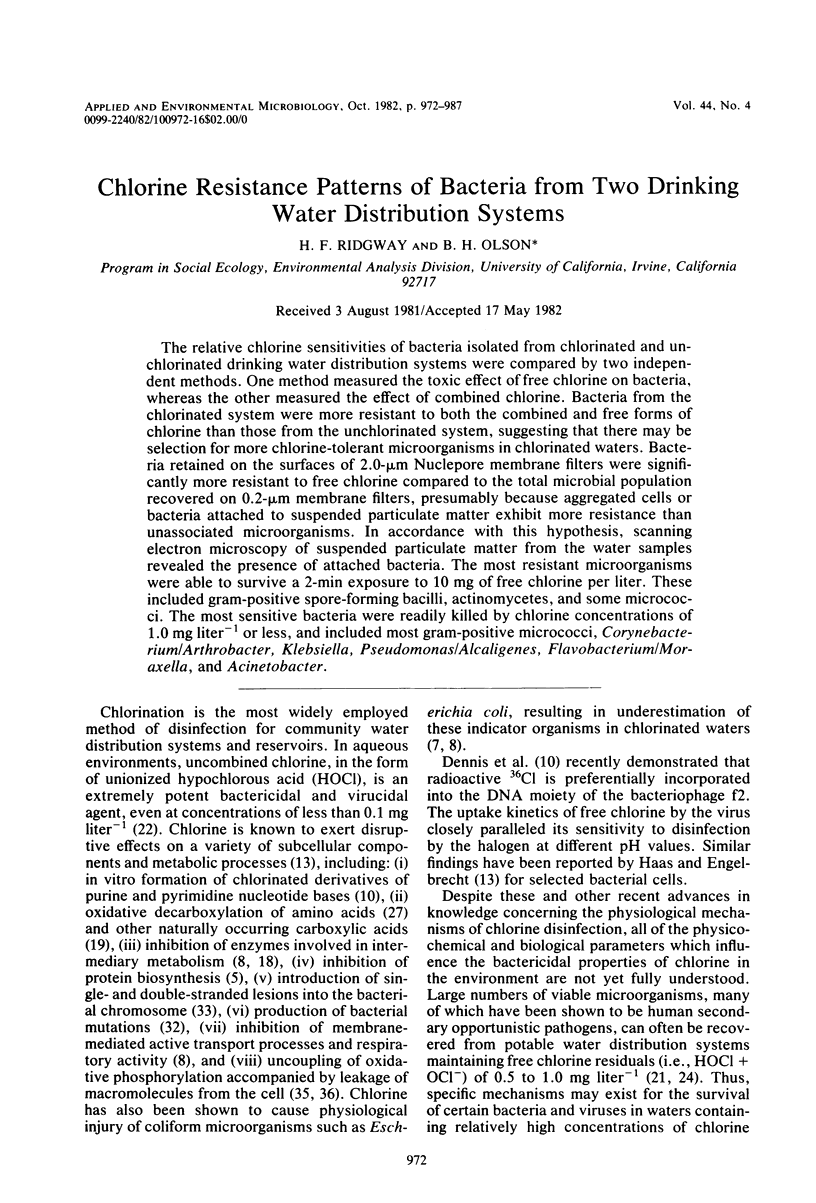
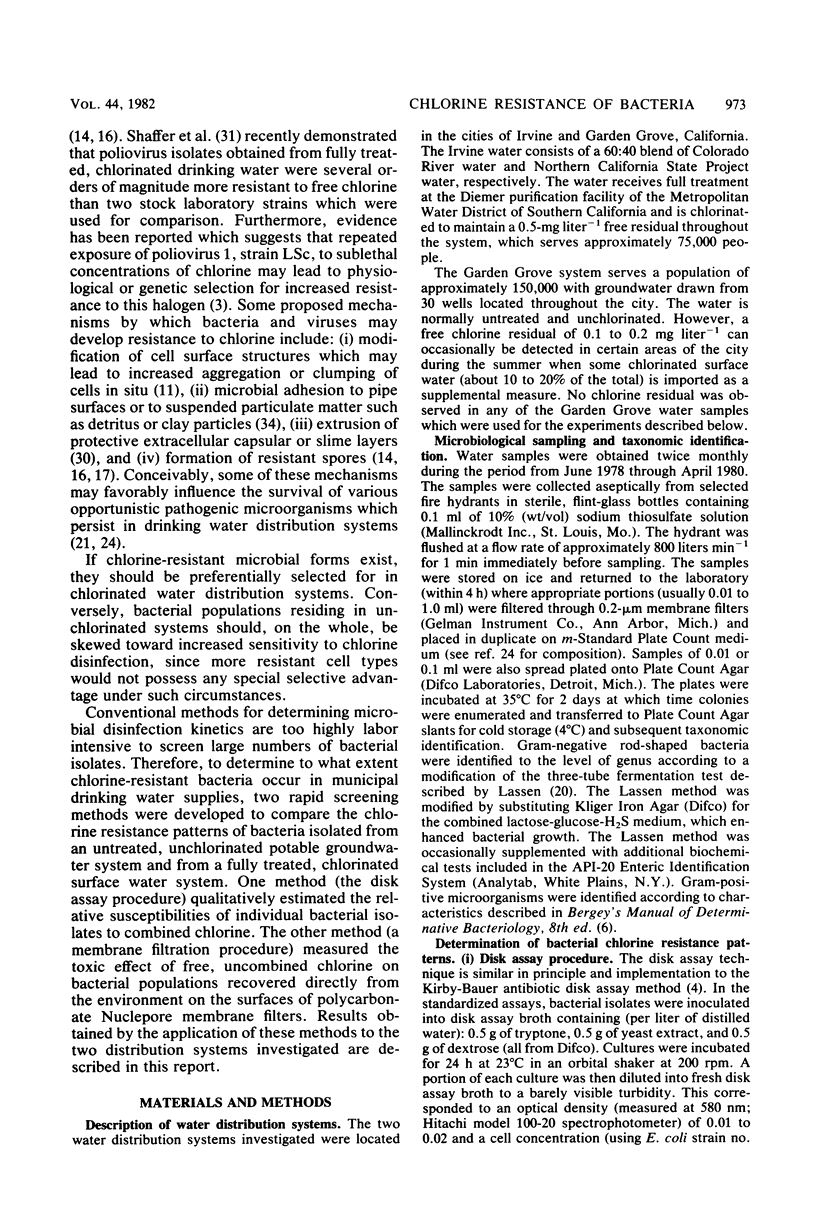

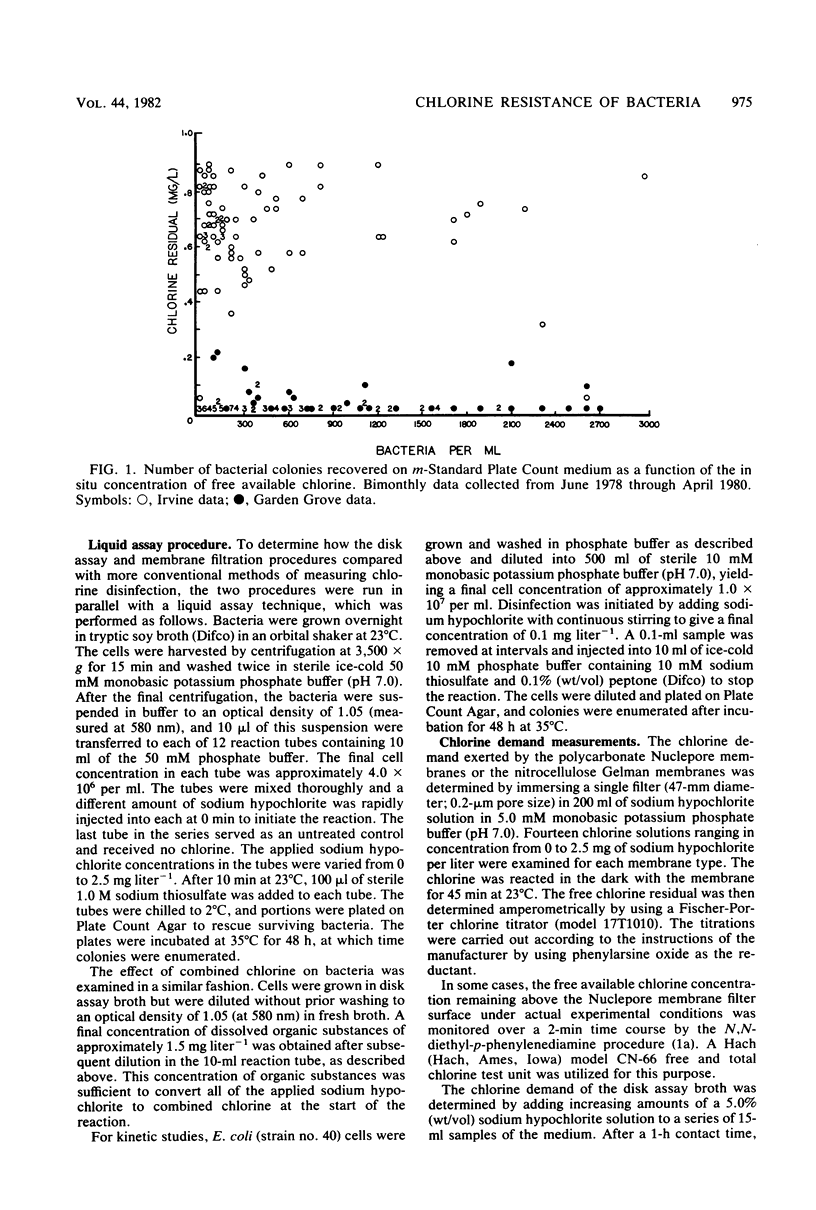
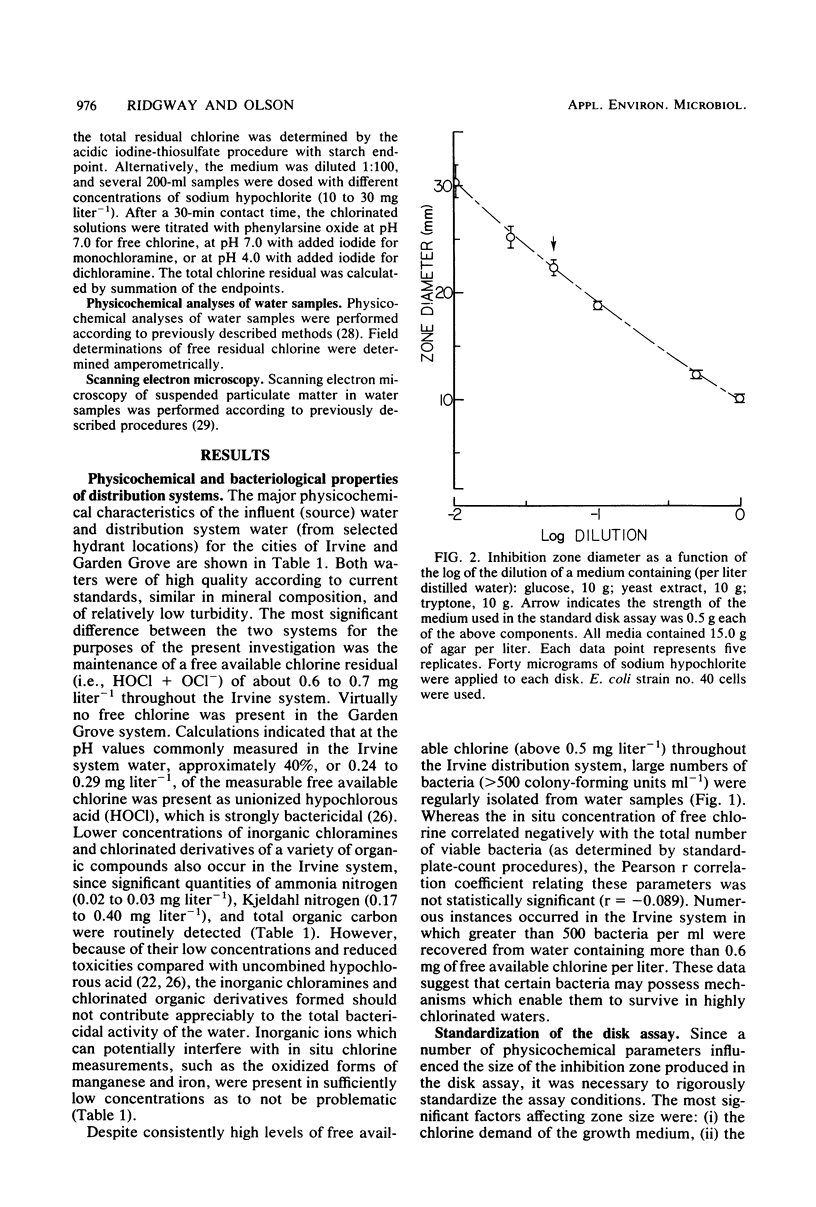
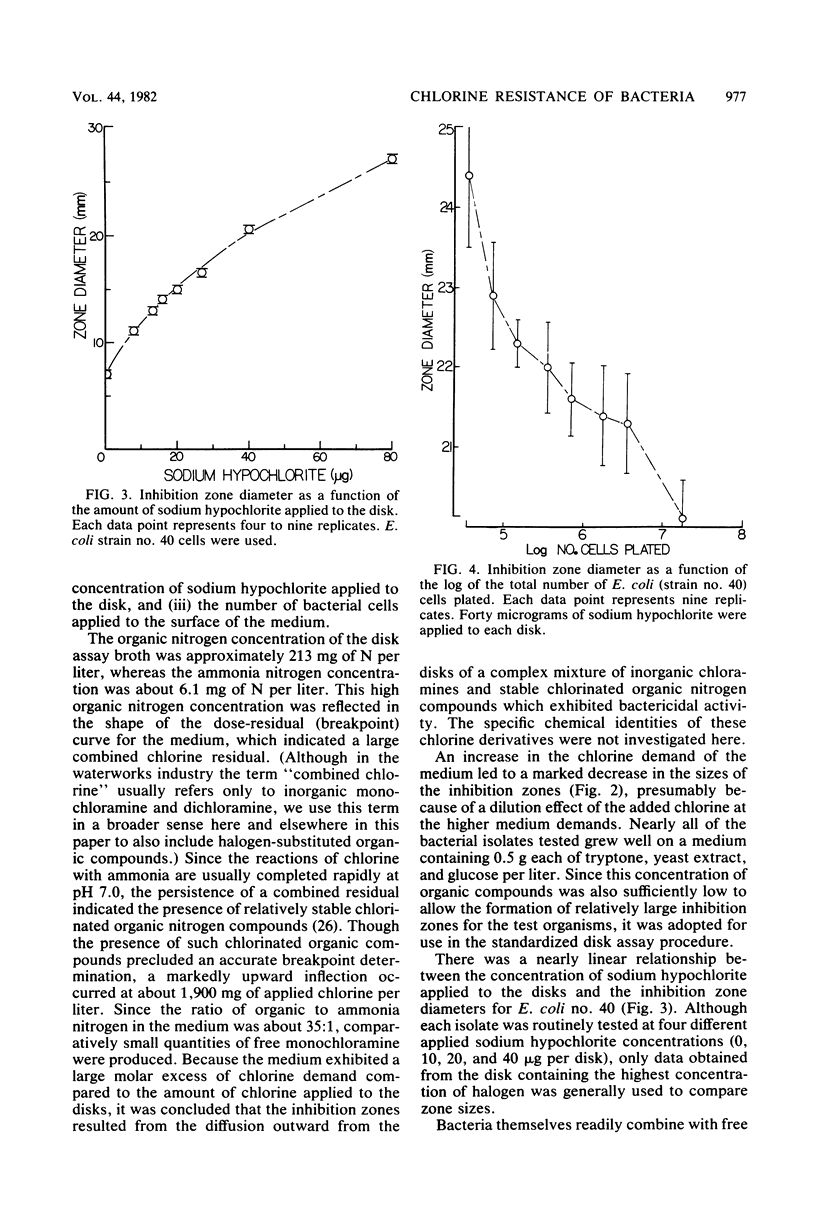



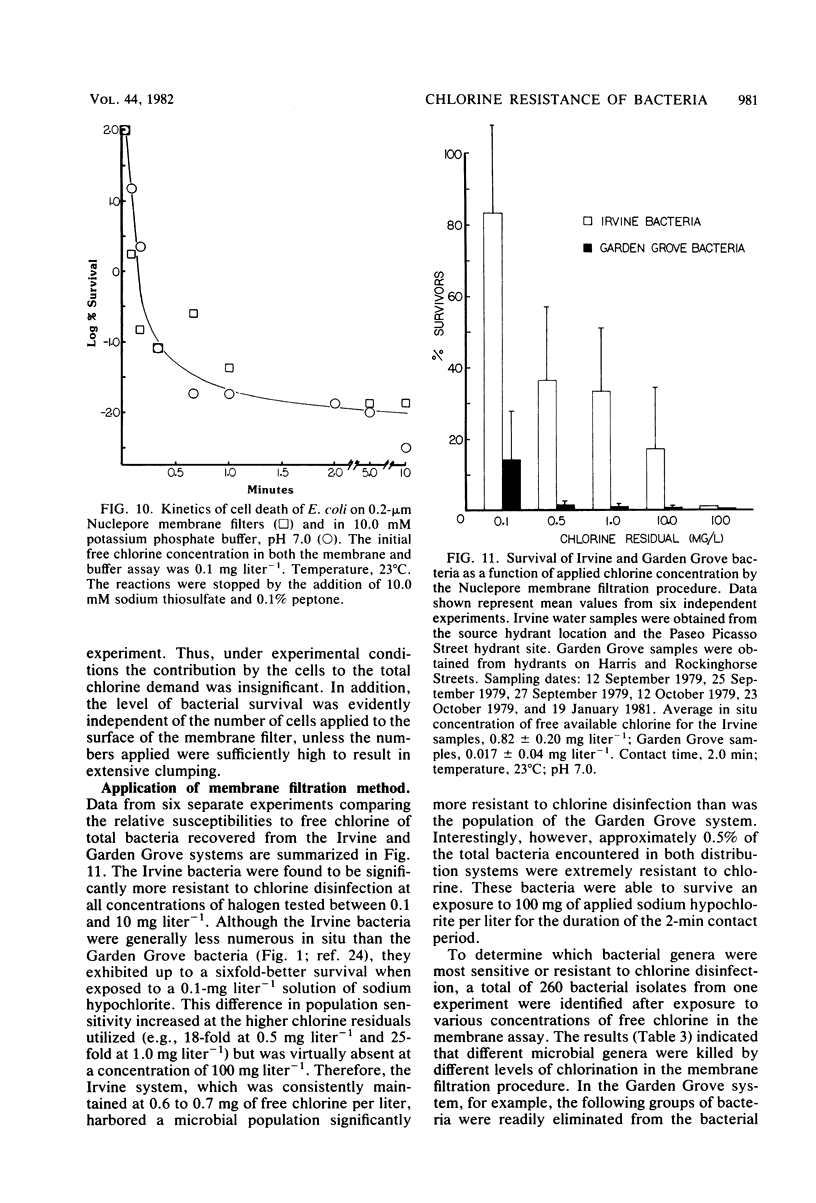
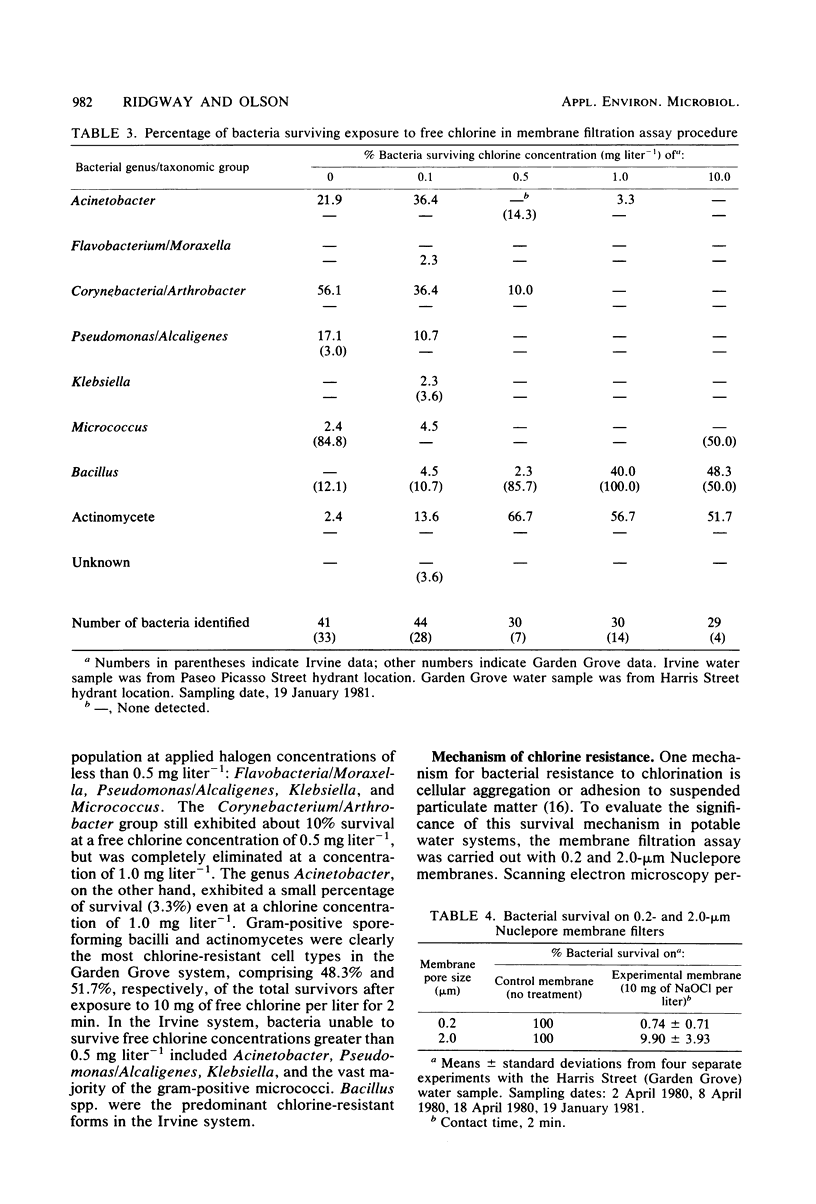
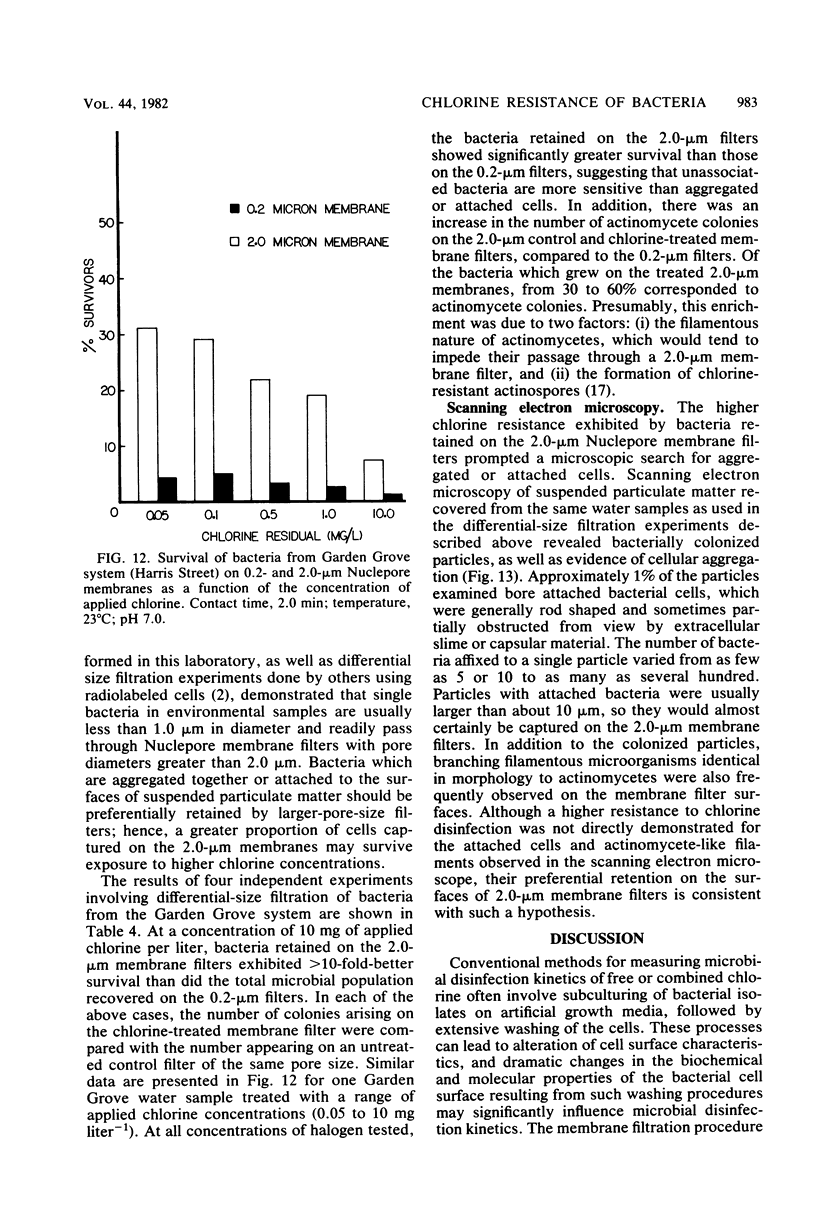
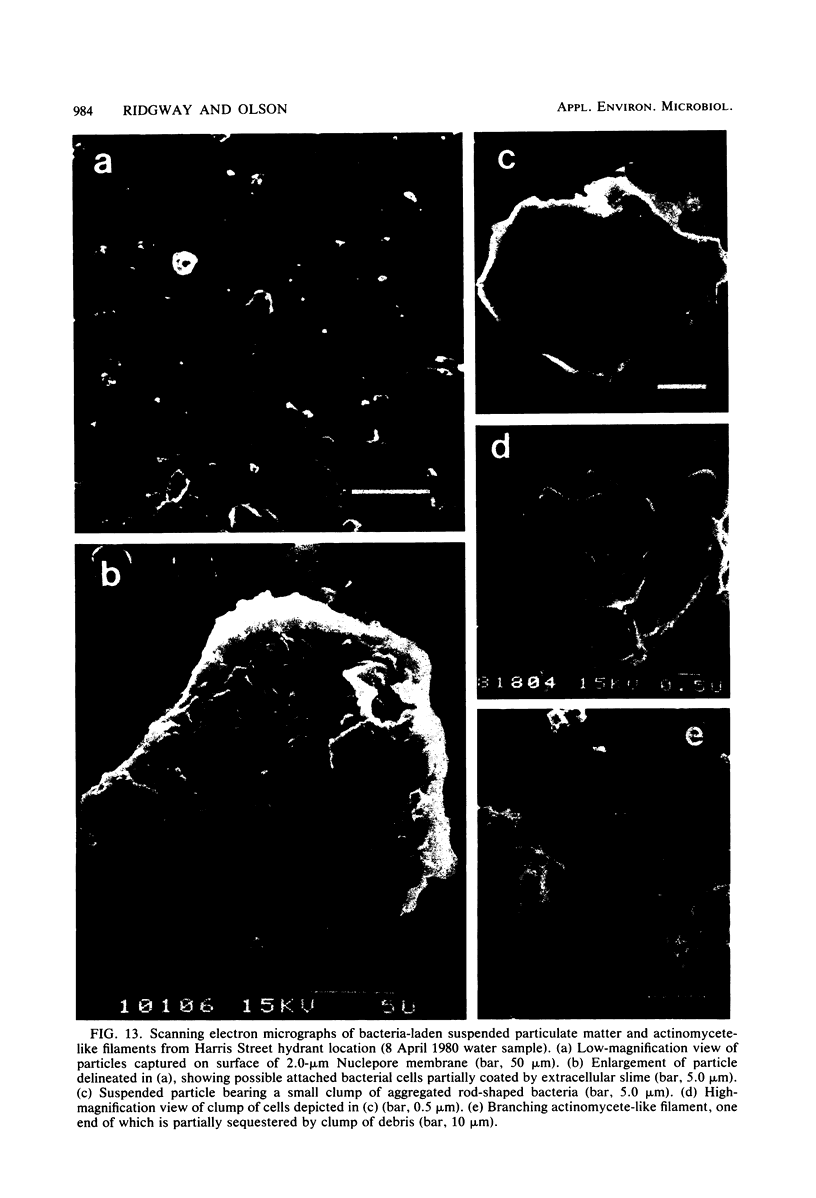

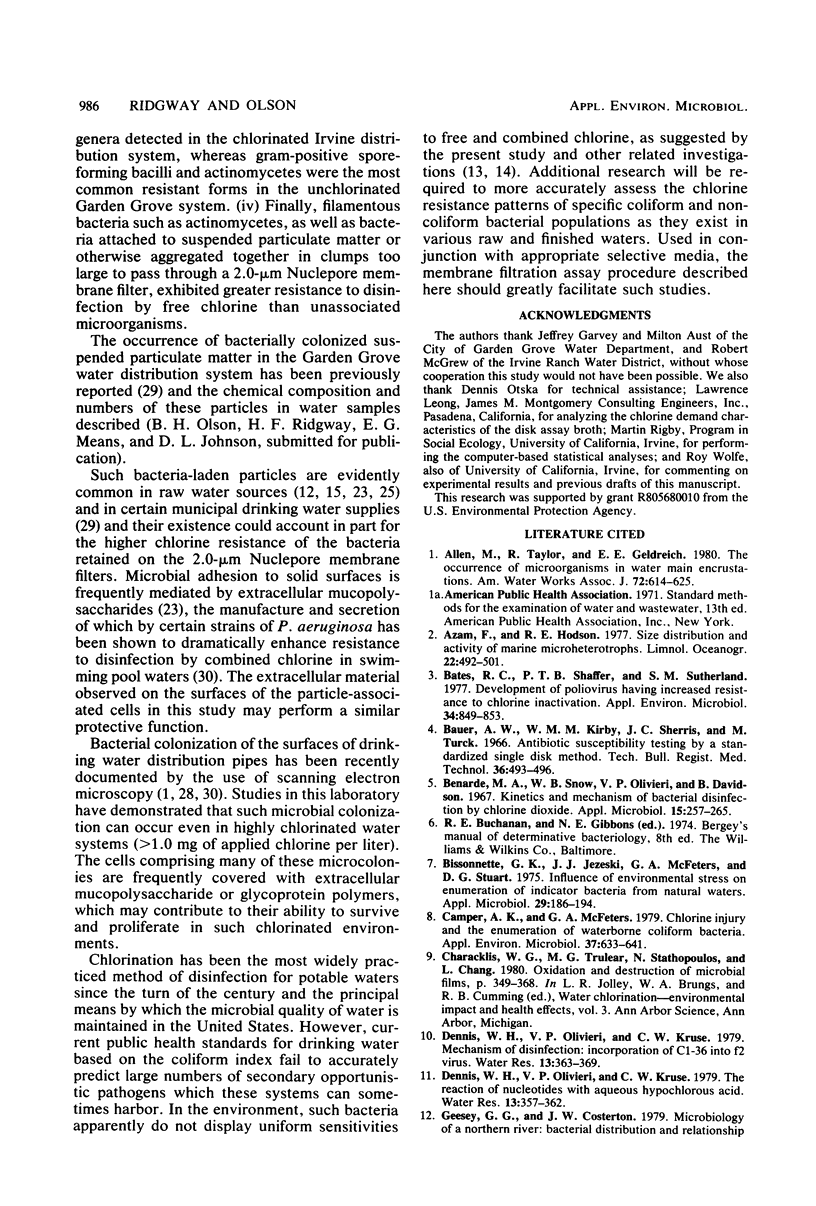
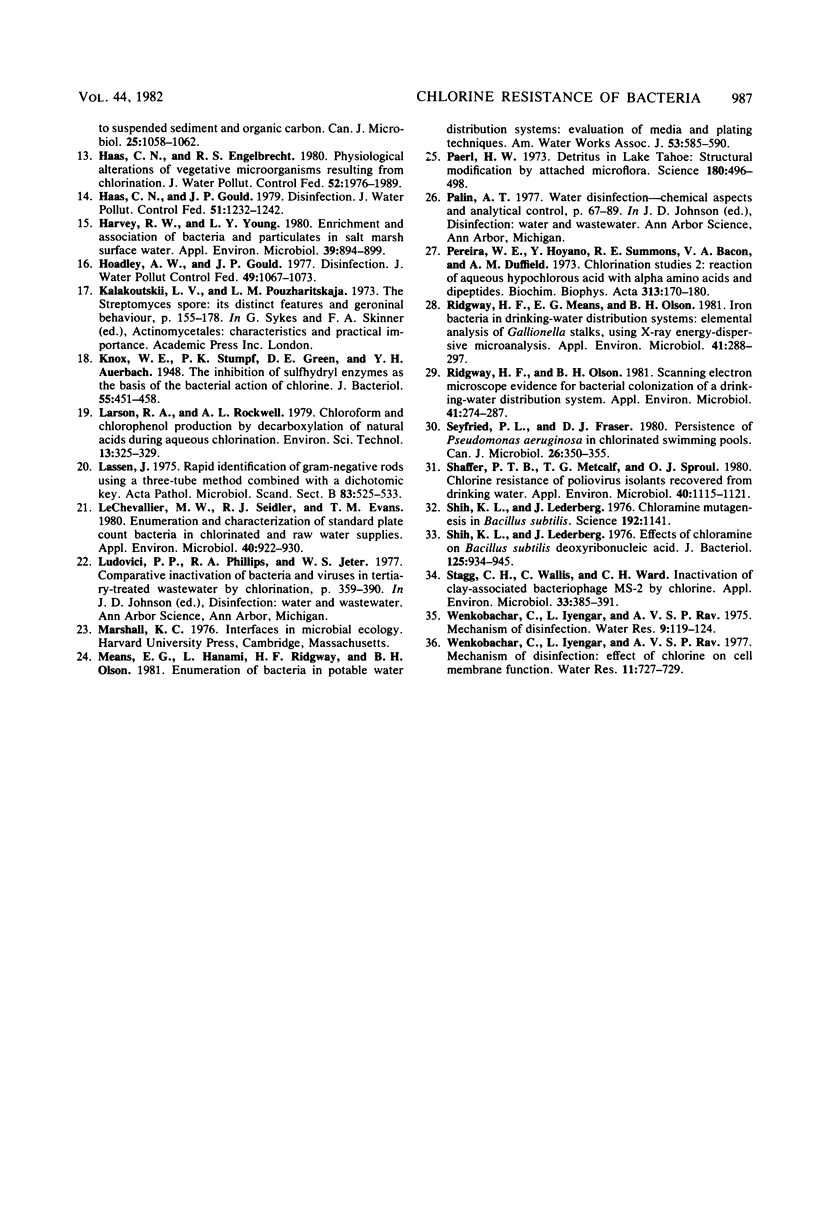
Images in this article
Selected References
These references are in PubMed. This may not be the complete list of references from this article.
- Bates R. C., Shaffer P. T., Sutherland S. M. Development of poliovirus having increased resistance to chlorine inactivation. Appl Environ Microbiol. 1977 Dec;34(6):849–853. doi: 10.1128/aem.34.6.849-853.1977. [DOI] [PMC free article] [PubMed] [Google Scholar]
- Benarde M. A., Snow W. B., Olivieri V. P., Davidson B. Kinetics and mechanism of bacterial disinfection by chlorine dioxide. Appl Microbiol. 1967 Mar;15(2):257–265. doi: 10.1128/am.15.2.257-265.1967. [DOI] [PMC free article] [PubMed] [Google Scholar]
- Bissonnette G. K., Jezeski J. J., McFeters G. A., Stuart D. G. Influence of environmental stress on enumeration of indicator bacteria from natural waters. Appl Microbiol. 1975 Feb;29(2):186–194. doi: 10.1128/am.29.2.186-194.1975. [DOI] [PMC free article] [PubMed] [Google Scholar]
- Camper A. K., McFeters G. A. Chlorine injury and the enumeration of waterborne coliform bacteria. Appl Environ Microbiol. 1979 Mar;37(3):633–641. doi: 10.1128/aem.37.3.633-641.1979. [DOI] [PMC free article] [PubMed] [Google Scholar]
- Geesey G. G., Costerton J. W. Microbiology of a northern river: bacterial distribution and relationship to suspended sediment and organic carbon. Can J Microbiol. 1979 Sep;25(9):1058–1062. doi: 10.1139/m79-162. [DOI] [PubMed] [Google Scholar]
- Haas C. N., Engelbrecht R. S. Physiological alterations of vegetative microorganisms resulting form chlorination. J Water Pollut Control Fed. 1980 Jul;52(7):1976–1989. [PubMed] [Google Scholar]
- Harvey R. W., Young L. Y. Enrichment and association of bacteria and particulates in salt marsh surface water. Appl Environ Microbiol. 1980 Apr;39(4):894–899. doi: 10.1128/aem.39.4.894-899.1980. [DOI] [PMC free article] [PubMed] [Google Scholar]
- Hoadley A. W., Gould J. P. Disinfection. J Water Pollut Control Fed. 1977 Jun;49(6):1067–1074. [PubMed] [Google Scholar]
- Kalakoutskii L. V., Pouzharitskaja L. M. The Streptomyces spore: its distinct features and germinal behaviour. Soc Appl Bacteriol Symp Ser. 1973 Jan;2:155–178. [PubMed] [Google Scholar]
- Knox W. E., Stumpf P. K., Green D. E., Auerbach V. H. The Inhibition of Sulfhydryl Enzymes as the Basis of the Bactericidal Action of Chlorine. J Bacteriol. 1948 Apr;55(4):451–458. [PMC free article] [PubMed] [Google Scholar]
- Lassen J. Rapid identification of gram-negative rods using a three-tube method combined with a dichotomic key. Acta Pathol Microbiol Scand Suppl. 1975 Dec;83(6):525–533. doi: 10.1111/j.1699-0463.1975.tb00134.x. [DOI] [PubMed] [Google Scholar]
- LeChevallier M. W., Seidler R. J., Evans T. M. Enumeration and characterization of standard plate count bacteria in chlorinated and raw water supplies. Appl Environ Microbiol. 1980 Nov;40(5):922–930. doi: 10.1128/aem.40.5.922-930.1980. [DOI] [PMC free article] [PubMed] [Google Scholar]
- Lu Shih K., Lederberg J. Effects of chloramine on Bacillus subtilis deoxyribonucleic acid. J Bacteriol. 1976 Mar;125(3):934–945. doi: 10.1128/jb.125.3.934-945.1976. [DOI] [PMC free article] [PubMed] [Google Scholar]
- Paerl H. W. Detritus in lake tahoe: structural modification by attached microflora. Science. 1973 May 4;180(4085):496–498. doi: 10.1126/science.180.4085.496. [DOI] [PubMed] [Google Scholar]
- Pereira W. E., Hoyano Y., Summons R. E., Bacon V. A., Duffield A. M. Chlorination studies. II. The reaction of aqueous hypochlorous acid with alpha-amino acids and dipeptides. Biochim Biophys Acta. 1973 Jun 20;313(1):170–180. doi: 10.1016/0304-4165(73)90198-0. [DOI] [PubMed] [Google Scholar]
- Ridgway H. F., Means E. G., Olson B. H. Iron bacteria in drinking-water distribution systems: elemental analysis of gallionella stalks, using x-ray energy-dispersive microanalysis. Appl Environ Microbiol. 1981 Jan;41(1):288–297. doi: 10.1128/aem.41.1.288-297.1981. [DOI] [PMC free article] [PubMed] [Google Scholar]
- Ridgway H. F., Olson B. H. Scanning electron microscope evidence for bacterial colonization of a drinking-water distribution system. Appl Environ Microbiol. 1981 Jan;41(1):274–287. doi: 10.1128/aem.41.1.274-287.1981. [DOI] [PMC free article] [PubMed] [Google Scholar]
- Seyfried P. L., Fraser D. J. Persistence of Pseudomonas aeruginosa in chlorinated swimming pools. Can J Microbiol. 1980 Mar;26(3):350–355. doi: 10.1139/m80-057. [DOI] [PubMed] [Google Scholar]
- Shaffer P. T., Metcalf T. G., Sproul O. J. Chlorine resistance of poliovirus isolants recovered from drinking water. Appl Environ Microbiol. 1980 Dec;40(6):1115–1121. doi: 10.1128/aem.40.6.1115-1121.1980. [DOI] [PMC free article] [PubMed] [Google Scholar]
- Shih K. L., Lederberg J. Chloramine mutagenesis in Bacillus subtilis. Science. 1976 Jun 11;192(4244):1141–1143. doi: 10.1126/science.818709. [DOI] [PubMed] [Google Scholar]




